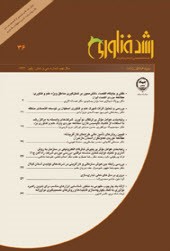ارائه يك چارچوب مفهومي به منظور شناسایی ابزارهای مناسب برای تدوین راهبرد نوآوری به کمک یکپارچهسازی قابلیتها و روشهای تصمیمگیری نوآورانه
محورهای موضوعی : نوآوري و خلاقيتفرهاد شاهمیری 1 , ناصر امن پور 2
1 - -
2 - -
کلید واژه: راهبرد نوآوری, قابلیتهای نوآورانه, روش تصمیمگیری نوآورانه, رویکردهای نوآورانه, نوآوری فنی- مهندسی.,
چکیده مقاله :
یکی از دشوارترین چالشهای پیش روی مدیران امروزی، مدیریت نوآوری فناورانه است که منجر به ارزش آفرینی، سودآوری، ایجاد رقابتپذیری پایدار، محیطهای کاری فرحبخش و جذب و نگهداری نیروهای خلاق و بهرهور ميگردد. مدیریت موفقیتآمیز نوآوری فناورانه زمانی روی ميدهد که مجموعه گستردهاي از عناصر و فعالیتهای سازمانی به خوبی مدیریت شده و در چارچوب راهبرد نوآوری سازمان با یکدیگر یکپارچه گردند. یکی از مفاهیم مورد بحث در راهبرد نوآوری، قابلیتهای نوآورانه است. قابليتهاي نوآورانه، به عنوان مجموعه الگوهاي مهارتي مورد استفاده شركتها براي تدوين و پيادهسازي راهبرد نوآوری تعریف ميگردد. در هر مرحله از این فرايند، ابزارهای گوناگونی مورد استفاده قرار ميگیرد. انتخاب نوع ابزار مناسب، با توجه به معیارهای گوناگونی صورت ميپذیرد. برخی از این معیارها عبارتند از: ساده يا پيچيده بودن خدمات و محصولات شرکت و میزان عدم اطمینان نسبت به بازارهاي آتي احتمالي و محيطهاي رقابتي براي فناوري جديد. در این مقاله با استفاده از یک رویکرد یکپارچه در روش تصمیمگیری و روش نوآورانه که مبتنی بر نوآوری فنی- مهندسی است ابزارهای مناسب در هر مرحله از قابلیتهای نوآورانه، معرفی ميشود. برخی از پرکاربردترین این ابزارها عبارتند از ماتریس SWOT، تکنیک دلفی، نظریه خلاقانه حل مسأله (TRIZ)، پیشبینیهاي آماری، تحلیل سلسله مراتبی، روش تاگوچی، 6 سیگما و ساير.
Of all the aspects of management of technological innovation (MTI), innovation strategy is the most challenging. Appropriate MTI, leads to value delivery, sustaining competitiveness, profit making, refreshing working environments, maintaining and retaining productive labor. Successful MTI occurs solely when a broad set of elements and organizational activities are well managed and integrated within innovation strategy of organization. Firms can be very good at the various activities involved in MTI, such as R&D or operations, but this accounts for little unless it is supported by a well-grounded innovation strategy that guides firms’ choices, prioritizations, and sequences. One of the concepts in the field of innovation strategy is innovative capabilities. Innovative capabilities are defined as bundles and patterns of skills used by firms to formulate and implement an innovation strategy involving the creation, extension, and modification of those resources and skills used for innovation. In each phase of the innovation strategy formulation, different tools may be used. Choosing the right tool depends on various criteria. Some of the criteria are as follows: Is firm new or well established, large or small, centralized or dispersed in its organization, deals in simple or complex products and services, operates within well-defined or uncertain technological and market circumstances, with a major or minor impact on society, safety, and the environment. In the article, using an integrated approach of innovative method and innovative decision-making method based on engineering technical innovation, and innovative capabilities, right tools in each phase of innovative capabilities, which finally leads to strategy formulation, is recognized. Some of the most practical tools are SWOT analysis and Delphi.

